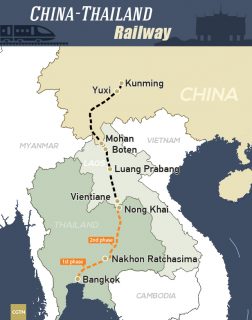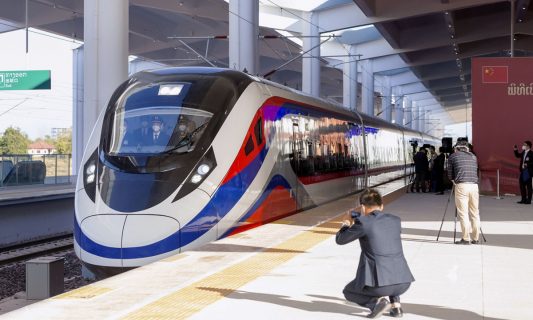Also called the Boten–Vientiane railway, the China-Laos railway is a 414-kilometer standard gauge electrified railway which is under construction between Vientiane, the capital of Lao, and Boten, a small town on the border with China. The railway line will be connected to the Chinese rail system in Mohan to the north through the Yuxi–Mohan railway. To the south, the China-Laos railway will connect with the current meter-gauge railway in Thanaleng. The railway line is expected to be an important part of the Kunming–Singapore railway.
According to Ding He, a deputy project manager for the China–Laos railway project, China intends to construct a 5,500km Trans-Asia railway which will begin from Kunming, the provisional capital of Yunnan and go through Laos, Myanmar, Thailand, Vietnam, Cambodia and Malaysia. The railway line will end in Singapore. The Boten–Vientiane railway is part of the Belt and Road Initiative.
Financing of Boten–Vientiane railway
The project is expected to cost around $6 billion. Out of this, Lao government will borrow $3.6 billion (60%) from the Export-Import Bank of China. The remaining $2.4 billion (40%) will be funded by a joint venture company between the two countries.
The reason behind the construction of the railway
Being the only landlocked country in Southeast Asia, Laos presents a hindrance to free flow of trade with her neighbors. The railway line constructed by the French colonialists did not reach Laos and only the 7 km Don Det–Don Khon railway was constructed. China is muting construction of the Trans-Asia railway as a way to reduce cargo transit time as well as transportation costs between China and Laos.

Project highlights
475 of the China–Laos railway is in 75 tunnels while 15% passes over viaducts spread over 167 bridges. There are 32 stations throughout the entire line with the last one being Thanaleng station. The Vientiane Station is the largest station on the railway and consists of four platforms with seven-track lines and two additional platforms with three lines reserved. The station will have a total area of 14,543 square meters, enough to accommodate 2,500 passengers.
The railway is built to China’s GB Grade 1 standard which suitable for 120 km/h freight and 160 km/h passenger trains. This makes Laos the first country to connect to the Chinese railway network using Chinese technology. There are plans to construct a bridge Thanaleng to Nong khai to connect the high-speed rail network into Thailand. The bridge will be completed by 2023.
Timeline
2001
The first talks about a railway line linking China and Laos were held in 2001.
2009
In 2009, both Chinese and Laotian authorities confirmed ongoing plans to construct the railway. On the Laotian side, talks were led by Somsavat Lengsavad.
2016
The project officially started in 2016 after being delayed following the corruption scandal of China’s minister of railways Liu Zhijun. Construction of the railway line started on December 25, 2016, and by the end of 2017, it was 20% complete. In September 2019, the project was reported to be 80% complete.
2020
In June, Chines state media reported that the project was 90% complete. Work crews started laying track in Laos in March 2020, five years after construction started. With all of the many dozen tunnels and bridges completed, service is set to start in December 2021.
In November 2020, 55 Lao National Assembly (NA) members conducted an observation tour of the China-Laos railway rail-welding yard. The observation group also took a train tour of the project and have first-hand experience.
October 2021.

The engineers are now working on the final touches to the China-Laos Railway’s Friendship Tunnel, the cross-border tunnel linking Mohan in southwestern China’s Yunnan Province and Boten in northern Laos, with its operations set to start in December.
The tunnel has a total length of 9,595 meters with 2,425 meters being on the Lao section. It was named Friendship Tunnel for a better demonstration of the traditional friendship between China and Laos. During the tunnel construction, done by China Railway No. 2 Engineering Group (CREC-2), a pair of mentor and protege drilled respectively from both sides of the tunnel and competed in progress and quality.
November 2021
The trial operation of the passenger service information systems installed at the 10 railway stations in Lao was completed, and they all passed the trial operation. Built by the electrification engineering branch of China Railway Construction Corporation (CRCC) and designed by China Railway Eryuan Engineering Group, the systems mainly include ticket system, integrated station management platform, passenger broadcasting system, integrated display system, and video surveillance system, among others.
The 10 stations are now ready for operation with railway staff having been put in place for the opening of the railway starting from December 2021 for freight transport. A precise date for the start of passenger services has not yet been decided.
End of November 2021
China’s National Railway Administration (NRA) and Laos’ Ministry of Public Works and Transport representing their respective governments signed the first inter-governmental agreement on railway cooperation for the 1,035-kilometer China-Laos railway, creating a framework for cross-border transportation.
The agreement will serve as a legal framework for the cross-border movement of people and goods along the railway at the border, and it will ensure the smooth operation of the railway.
December 2021

The signature project under the China-proposed Belt and Road Initiative, officially went into full operation on Friday, 3rd of December catapulting the landlocked Southeast Asian nation (Laos) into a Chinese standard-powered modern railway era that honors China’s promise of enabling inclusive growth along the BRI routes.
The first train of the China-Laos Railway left on Friday afternoon soon after the cross-border railway was officially put into operation. Among the cargo loaded on the train were potash products manufactured by a China-Laos joint venture dubbed Sino-Agri International Potash Company.

When is it possible for passengers to go on the train from Laos to China?
Best regards
Inger
Great to read about the initiative. When is it possible for passengers to go on the train from Laos to China?